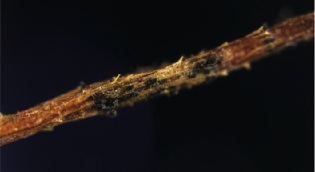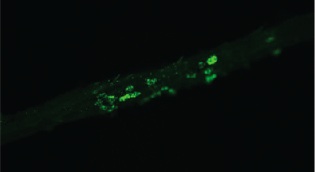PESTS AND DISEASES OF FORESTRY IN NEW ZEALAND
How do epidemics of fungal forest pathogens occur?
From Biosecurity 89, February 2009.
Scientists are investigating the potential for biocontrol against Dothistroma (red-band) needle blight, which has a major affect on New Zealand's forest plantations.
Dothistroma needle blight is a fungal disease of trees, mainly affecting pines, that was first found in New Zealand 50 years ago. The impact on the forest plantation industry includes:
- Significant loss of growth in affected trees:
- without spraying, the likely cost to the industry would be in the order of $60 million a year in lost productivity;
- with spraying, the loss is probably closer to $20 million a year.
- High cost of control:
- depending on rainfall (which increases infection levels), the forest industry sprays 70,000 to 180,000 hectares a year at an average cost of about $35 per hectare.
- Reduction in the number of pine species that can be grown economically and limits on the range of species, such as Pinus nigra and Pinus ponderosa.


required for needle infection.
Photos courtesy Massey University.
Dothistroma needle blight has now reached epidemic levels in parts of Canada and Europe. Although climate change has been implicated, it is not known whether genetic changes in the pathogen have also contributed to these epidemics.
Dr Rosie Bradshaw, from Massey University, and Dr Rebecca Ganley, from the Crown Research Institute Scion (both organisations being members of the Bio-protection Research Centre), are in the initial stages of a research project to investigate how the Dothistroma pathogens have evolved over the short to long term.
Dr Bradshaw has also been investigating the role of the toxin dothistromin, which is present in Dothistroma-infected needles. She and co-workers have recently disproved the hypothesis that the toxin is required for pathogenicity of the Dothistroma fungus (Dothistroma septosporum) on radiata pine.
However, there is evidence that dothistromin may play a role in competition against other fungi in pine needles.
The researchers are currently investigating the potential for biocontrol against pathogenic fungal infection. Should this be successful, it may be possible, for example, to manipulate the endophytes (organisms that live naturally in plants) living in radiata pine needles to enhance the presence of the most beneficial ones thereby increasing the resistance of radiata pine to needle cast diseases.
This would be worth many tens of millions of dollars a year to the New Zealand plantation forest industry if disease-resistance trees were deployed on a large scale.
Dr Rosie Bradshaw, Massey University, R.E.Bradshaw@massey.ac.nz



